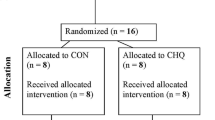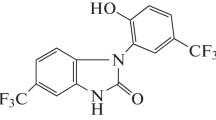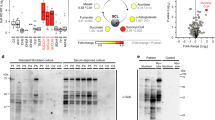Abstract
Ethylmalonic aciduria is a common finding in patients affected by short-chain acyl-CoA dehydrogenase (SCAD) deficiency and other diseases characterized by encephalopathy, muscular symptomatology, and lactic acidemia. Considering that the pathophysiological mechanisms of these disorders are practically unknown and that lactic acidosis suggest an impairment of energy production, the objective of the present work was to investigate the in vitro effect of ethylmalonic acid (EMA), at concentrations varying from 0.25 to 5.0 mM, on important parameters of energy metabolism in human skeletal muscle, such as the activities of the respiratory chain complexes and of creatine kinase, which are responsible for most of the ATP produced and transferred inside the cell. We verified that EMA significantly inhibited the activity of complex I–III at concentrations as low as 0.25 mM, complex II–III at 1 mM and higher concentrations, and complex II at the concentration of 5 mM. In contrast, complex IV was not inhibited by the acid. Finally, we observed that the activity of creatine kinase was significantly inhibited by EMA at the concentrations of 1 and 5 mM. These results suggest that EMA compromises energy metabolism in human skeletal muscle. In case the in vitro effects detected in the present study also occur in vivo, it is tempting to speculate that they may contribute, at least in part, to explain the hypotonia/myopathy, as well as the increased concentrations of lactic acid present in the patients affected by illnesses in which EMA accumulates.


Similar content being viewed by others
References
Amendt BA, Greene C, Sweetman L, Cloherty J, Shih V, Moon A, Teel L, Rhead WJ (1987) Short-chain acyl-coenzyme A dehydrogenase deficiency clinical and biochemical studies in two patients. J Clin Invest 79:1303–1309
Aoyama T, Uchida Y, Kelley RI, Marble M, Hofman K, Tonsgard JH, Rhead WJ, Hashimoto T (1993) A novel disease with deficiency of mitochondrial very-long-chain acyl-CoA dehydrogenase. Biochem Biophys Res Commun 191:1369–1372
Bär PRD (2000) Chronic mitochondrial inhibition induces selective motoneuron death in vitro. J Neurochem 74:1158–1165
Bennett MJ, Weinberger MJ, Kobori JA, Rinaldo P, Burlina AB (1996) Mitochondrial short-chain L-3-hydroxyacyl-coenzyme A dehydrogenase deficiency: A new defect of fatty acid oxidation. Pediatr Res 39:185–188
Bertrand C, Largilliere C, Zabot MT, Mathieu M, Vianey-Saban C (1993) Very-long-chain acyl-CoA dehydrogenase deficiency: Identification of a new inborn error of mitochondrial fatty acid oxidation in fibroblasts. Biochim Biophys Acta 1180:327–329
Brandao ML, Roselino JE, Piccinato CE, Cherri J (2003) Mitochondrial alterations in skeletal muscle submitted to total ischemia. J Surg Res 110:235–240
Brusque AM, Borba Rosa R, Schuck PF, Dalcin KB, Ribeiro CA, Silva CG, Wannmacher CM, Dutra-Filho CS, Wyse AT, Briones P, Wajner M (2002) Inhibition of the mitochondrial respiratory chain complex activities in rat cerebral cortex by methylmalonic acid. Neurochem Int 40:593–601
Burlina AB, Dionisi-Vici C, Bennett MJ, Gibson KM, Servidei S, Bertini E, Hale DE, Schmidt-Sommerfeld E, Sabetta G, Zacchello F, Rinaldo P (1994) A new syndrome with ethylmalonic aciduria and normal fatty acid oxidation in fibroblasts. J Pediatr 124:79–86
da Silva CG, Ribeiro CA, Leipnitz G, Dutra-Filho CS, Wyse AT, Wannmacher CM, Sarkis JJ, Jakobs C, Wajner M (2002) Inhibition of cytochrome c oxidase activity in rat cerebral cortex and human skeletal muscle by D-2-hydroxyglutaric acid in vitro. Biochim Biophys Acta 1586:81–91
Dawson DB, Waber L, Hale DE, Bennett MJ (1995) Transient organic aciduria and persistent lacticacidemia in a patient with short-chain acyl-coenzyme. A dehydrogenase deficiency. J Pediatr 126:69–71
Di Donato S (2000) Disorders related to mitochondrial membranes: Pathology of the respiratory chain and neurodegeneration. J Inher Metab Dis 23:247–263
Duran M, Bruinvis L, Ketting D, de Clerk JB, Wadman SK (1988) Cis-4-decenoic acid in plasma: A characteristic metabolite in medium-chain acyl-CoA dehydrogenase deficiency. Clin Chem 34:548–551
Finocchiaro G, Ito M, Tanaka K (1988) Purification and properties of short-chain acyl-CoA, medium-chain acyl-CoA, and isovaleryl-CoA dehydrogenases from human liver. Adv Neurol 48:221–230
Fischer JC, Ruitenbeek W, Berden JA, Trijbels JM, Veerkamp JH, Stadhouders AM, Sengers RC, Janssen AJ (1985) Differential investigation of the capacity of succinate oxidation in human skeletal muscle. Clin Chim Acta 153:23–36
Garcia-Silva MT, Campos Y, Ribes A, Briones P, Cabello A, Santos Borbujo J, Arenas J, Garavaglia B (1994) Encephalopathy, petechiae, and acrocyanosis with ethylmalonic aciduria associated with muscle cytochrome c oxidase deficiency. J Pediatr 125:843
Garcia-Silva MT, Ribes A, Campos Y, Garavaglia B, Arenas J (1997) Syndrome of encephalopathy, petechiae, and ethylmalonic aciduria. Pediatr Neurol 17:165–170
Gregersen N, Winter VS, Corydon MJ, Corydon TJ, Rinaldo P, Ribes A, Martinez G, Bennett MJ, Vianey-Saban C, Bhala A, Hale DE, Lehnert W, Kmoch S, Roig M, Riudor E, Eiberg H, Andresen BS, Bross P, Bolund LA, Kolvraa S (1998) Identification of four new mutations in the short-chain acyl-CoA dehydrogenase (SCAD) gene in two patients: One of the variant alleles, 511C→T, is present at an unexpectedly high frequency in the general population, as was the case for 625G→A, together conferring susceptibility to ethylmalonic aciduria. Hum Mol Genet 7:619–627
Hughes BP (1962) A method for the estimation of serum creatine kinase and its use in comparing creatine kinase and aldolase activity in normal and pathological sera. Clin Chim Acta 7:597–603
Kibayashi M, Nagao M, Chiba S (1999) Influence of valproic acid on the expression of various acyl-CoA dehydrogenase in rats. Pediatr Int 41:52–60
Leipnitz G, Schuck PF, Ribeiro CA, Dalcin KB, Assis DR, Barschak AG, Pulrolnik V, Wannmacher CM, Wyse AT, Wajner M (2003) Ethylmalonic acid inhibits mitochondrial creatine kinase activity from cerebral cortex of young rats in vitro. Neurochem Res 28:771–777
Lowry OH, Rosebrough NJ, Farr AL, Randall RJ (1951) Protein measurement with the Folin phenol reagent. J Biol Chem 193:265–275
Mekhfi H, Veksler V, Mateo P, Maupoil V, Rochette L, Ventura-Clapier R (1996) Creatine kinase is the main target of reactive oxygen species in cardiac myofibrils. Circ Res 78:1016–1027
Meyer RA, Brown TR, Krilowicz BL, Kushmerick MJ (1986) Phosphagen and intracellular pH changes during contraction of creatine-depleted rat muscle. Am J Physiol 250:C264–C274
Nathan C, Xie QW (1994) Nitric oxide synthases: Roles, tools, and controls. Cell 78:915–918
Oldendorf WH (1973) Carrier-mediated blood–brain barrier transport of short chain monocarboxylic organic acids. Am J Physiol 224:1450–1453
Onkenhout W, Venizelos V, Van der Poel PFH, Van der Heuvel MPM, Poorthuis BJHM (1995) Identification and quantification of intermediates of unsaturated fatty acid metabolism in plasma of patients with fatty acid oxidation disorders. Clin Chem 41:1467–1474
Ozand PT, Rashed M, Millington DS, Sakati N, Hazzaa S, Rahbeeni Z, Alodaib A, Youssef N, Mazrou A, Gascon GG, Brismar J (1994) Ethylmalonic aciduria: An organic acidemia with CNS involvement and vasculopathy. Brain Dev 16:12–22
Roe CR, Coates PM (1995) Mitochondrial fatty acid oxidation disorders In: Scriver CR, Beaudet AL, Sly WS, Valle D (eds) The metabolic and molecular bases of inherited disease, 7th edn. McGraw-Hill, New York, pp 1501–1533
Roe CR, Ding J (2001) Mitochondrial fatty acid oxidation disorders. In: Scriver CR, Beaudet AL, Sly WS, Valle D (eds) The metabolic and molecular bases of inherited disease, 8th edn. McGraw-Hill, New York, pp 2297–2326
Rustin P, Chretien D, Bourgeron T, Gerard B, Rotig A, Saudubray JM, Munnich A (1994) Biochemical and molecular investigations in respiratory chain deficiencies. Clin Chim Acta 228:35–51
Saks VA, Ventura-Clapier R, Aliev MK (1996) Metabolic control and metabolic capacity: Two aspects of creatine kinase functioning in the cells. Biochim Biophys Acta 1274:81–88
Saupe KW, Spindler M, Tian R, Ingwall JS (1998) Impaired cardiac energetics in mice lacking muscle-specific isoenzymes of creatine kinase. Circ Res 82:898–907
Schapira AH, Cooper JM, Dexter D, Clark JB, Jenner P, Marsden CD (1990) Mitochondrial complex I deficiency in Parkinson’s disease. J Neurochem 54:823–827
Scholte HR, Busch HF, Luyt-Houwen IE, Vaandrager-Verduin MH, Przyrembel H, Arts WF (1987) Defects in oxidative phosphorylation biochemical investigations in skeletal muscle and expression of the lesion in other cells. J Inherit Metab Dis 10:81–97
Schuck PF, Rosa RB, Pettenuzzo LF, Sitta A, Wannmacher CM, Wyse AT, Wajner M (2004) Inhibition of mitochondrial creatine kinase activity from rat cerebral cortex by methylmalonic acid. Neurochem Int 45:661–667
Schuck PF, Leipnitz G, Ribeiro CA, Dalcin KB, Assis DR, Barschak AG, Pulrolnik V, Wannmacher CM, Wyse AT, Wajner M (2002) Inhibition of creatine kinase activity in vitro by ethylmalonic acid in cerebral cortex of young rats. Neurochem Res 27:1633–1639
Shoffner JM (1997) Oxidative phosphorylation defects and Alzheimer’s disease. Neurogenetics 1:93–197
Shoubridge EA, Radda GK (1984) A 31P-nuclear magnetic resonance study of skeletal muscle metabolism in rats depleted of creatine with the analogue beta-guanidinopropionic acid. Biochim Biophys Acta 805:79–88
Stachowiak O, Dolder M, Wallimann T, Richter C (1998) Mitochondrial creatine kinase is a prime target of peroxynitrite-induced modification and inactivation. J Biol Chem 273:16694–16699
Steeghs K, Benders A, Oerlemans F, de Haan A, Heerschap A, Ruitenbeek W, Jost C, van Deursen J, Perryman B, Pette D, Bruckwilder M, Koudijs J, Jap P, Veerkamp J, Wieringa B (1997) Altered Ca2+ responses in muscles with combined mitochondrial and cytosolic creatine kinase deficiencies. Cell 89:93–103
van Deursen J, Heerschap A, Oerlemans F, Ruitenbeek W, Jap P, ter Laak H, Wieringa B (1993) Skeletal muscles of mice deficient in muscle creatine kinase lack burst activity. Cell 74:621–631
Wallimann T, Doler M, Schlattner U, Eder M, Hornemann T, Kraft T, Stolz M (1998) Creatine kinase: An enzyme with central role in cellular energy metabolism. Magn Reson Mater Phys Biol Med 6:116–119
Winkler-Stuck K, Kirches E, Mawrin C, Dietzmann K, Lins H, Wallesch CW, Kunz WS, Wiedemann FR (2005) Re-evaluation of the dysfunction of mitochondrial respiratory chain in skeletal muscle of patients with Parkinson’s disease. J Neural Transm 112:499–518
Wolosker H, Panizzutti R, Englender S (1996) Inhibition of creatine kinase by S-nitrosoglutathione. FEBS Lett 392:274–276
Yuan G, Kaneko M, Masuda H, Hon RB, Kobayashi A, Yamazaki N (1992) Decrease in heart mitochondrial creatine kinase activity due to oxygen free radicals. Biochim Biophys Acta 1140:78–84
Acknowledgment
This work was partly supported by grants from CNPq, PRONEX II, and FAPERGS.
Author information
Authors and Affiliations
Corresponding author
Rights and permissions
About this article
Cite this article
Barschak, A.G., Ferreira, G.d.C., André, K.R. et al. Inhibition of the Electron Transport Chain and Creatine Kinase Activity by Ethylmalonic Acid in Human Skeletal Muscle. Metab Brain Dis 21, 11–19 (2006). https://doi.org/10.1007/s11011-006-9000-y
Received:
Accepted:
Published:
Issue Date:
DOI: https://doi.org/10.1007/s11011-006-9000-y




